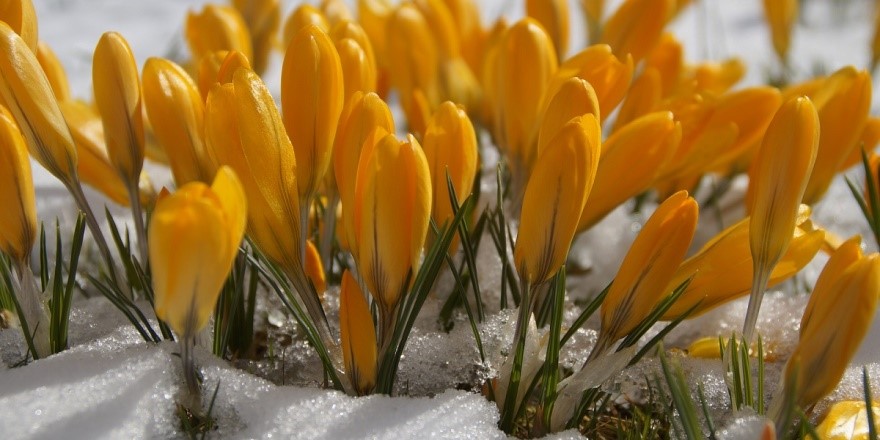Knowing how to protect plants from snow damage during the winter months can make or break your summer display.
Perennials, vegetables, shrubs, and trees, my tips and tricks cover them all.
Although hardy plants can withstand cold air and even frost, they will suffer under the weight of snow. To protect plants from snow damage of this sort, there are a few things you can do.

Firstly, after a heavy snowfall, we would recommend that you clear your pathways to allow easy access to the plants the may need your help.
Whilst one of the snow shovels recommended by Snow Blower Guides is ideal for this purpose. a decent snow shovel will also do the job.
Read on to protect your plants this winter.
Apart from the weight, does snow do any other damage to dormant cold-hardy plants? No, not really, the biggest danger comes in early spring when there is a risk of a cold snap.
Larger older trees will be fine and reach spring unscathed unless you are hit by very extreme cold weather.
(We cover how to protect plants from freezing temperatures further down the post, first, we would like to specifically discuss snow damage).
We have heard people recommending the pruning of larger plants. Therefore, providing fewer areas for the snow to settle on.
Although in itself, is a good idea you need to be careful, avoid pruning after the mid-summer.
When pruning is carried out, it can stimulate new growth, delaying the plant from going ‘winter dormant’.
If you become worried about too much snow gathering on the branches you can gently brush it off of the lower branches, using an upward motion.
Evergreens can be helped by tying in the branches, this will give them a little more protection from winter damage.
Remember, in low temperatures trees can become fragile. Branches break easily and will not only harm the tree but any nearby plants it may fall on.
Therefore, never shake the tree, and leave well alone if ice has formed.
Read Also:
You have invested both time and money in your landscape plants and shrubs, so protecting them throughout the winter is important.
Trees and shrubs are similar, in the fact, that there is not really a lot that can be done.
Where possible gently gather the branches and tie, either using garden string. This will reduce the possibility of them snapping under the snow accumulation.
When you feel that there is too much snow resting on them, simply gently brush it off with your hand or small broom.
Hardy perennial plants should be dormant during the winter months. But, as a lot of us find out the hard way, it can also snow in springtime.
Don’t worry there are steps you can take if the weather station forecasts late snow.
Simply cover your plants to protect them, this is not just effective, but a quick and easy solution. Get creative, it doesn’t have to be anything expensive or complicated.
Cut the base from an old milk jug or soda bottle over smaller plants, place an old shoebox or even plastic bins over potted plants.
Don’t forget to weigh them down with a rock or stake though and you must remember to remove the cover as soon as possible.
Just as with the hardy perennials, if you get caught with a late forecast for snow you can get inventive. By using the same methods for vegetable plants as I mentioned above for the perennials.
For a larger area, making a simple cloche will probably be the easiest solution. This will also come in handy for frost protection.
All gardeners know that frost is a plant’s worst enemy, along with garden pests of course. Fortunately, there are plenty of measures that you can take to protect small trees and other plants from frost.
Trees and shrubs are rarely affected by a freeze or frost or even frozen soil. By the time the air temperature drops that low larger plants are usually going into dormancy or already dormant.
When cold temperatures strike the growing season is almost, if not completely over for most plants.
Having said that, newly planted or young trees are susceptible to frost damage on the tree bark or sunscald, caused by winter sun warming during the day and air temperatures plummeting at night.
You can protect the trunk from this using an opaque plastic tree guard. These are readily available in garden centers and online.
For young vulnerable trees, it is essential that you protect them from temperatures below about 32 degrees.
This is easily done by covering them in breathable material, never use plastic covers for this purpose.
Using mulch in the garden during cold winter months is to regulate the temperature. In the first place, it keeps the ground warm.
But, as winter gets colder and the ground freezes, we need to keep stop the soil from warming again.
When the soil warms during the day and freezes again at night you risk the plant’s roots being pushed out of the soil. Severe damage that, I am afraid, will kill the individual plants.
Mulching plants and trees are the best gifts you could give your garden.
As we touched on above, it is necessary to cover plants with garden blankets or frost blankets in extreme conditions or on tender new growth or plants.
Old blankets or sheets that you no longer use are just as good, but be sure to use stakes to avoid contact with the plants.
Don’t let winter ruin your hard work, with a little bit of time and barely any expense you can have it blooming for Springtime and Summer.
I hope you have found this post interesting and helpful, here’s to a successful Winter for your garden.